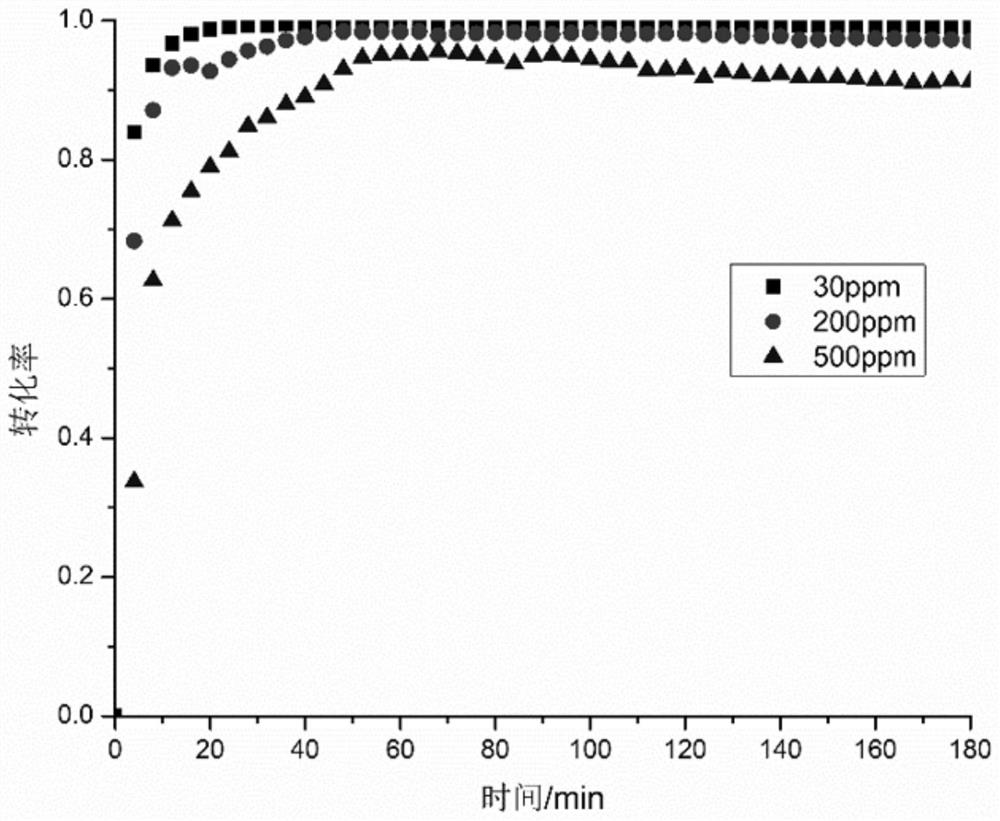Monolithic catalyst for catalyzing ozone to degrade VOCs as well as preparation and application of monolithic catalyst
A monolithic catalyst and ozone degradation technology, applied in physical/chemical process catalysts, molecular sieve catalysts, chemical instruments and methods, etc., can solve problems such as difficult balance between stability and mass transfer efficiency
- Summary
- Abstract
- Description
- Claims
- Application Information
AI Technical Summary
Problems solved by technology
Method used
Image
Examples
preparation example Construction
[0034] A kind of preparation method of catalytic ozone degrading VOCs monolithic catalyst of the present invention, preparation step is
[0035] (1) Substrate pretreatment
[0036] Inorganic ceramics are used as the substrate, and the substrate is pretreated by alkali washing and / or acid etching and / or heat treatment; specifically, this step is to heat the Y-type molecular sieve to 200-300°C in the air atmosphere, and pass in water vapor And raise the temperature to 650-850°C, keep it for 4-6 hours, then lower the temperature to 200-400°C and stop the introduction of water vapor, lower the temperature to below 100°C in the air atmosphere and take out the sample; then prepare 0.5-2mol / L of nitric acid solution, put the above-mentioned Y-type molecular sieve and nitric acid solution treated with water vapor into a three-necked flask at a solid-to-liquid ratio of 1: (8-12), and stir and react in a reflux device at 60-100°C 4 to 6 hours, after the reaction, the sample was washed...
Embodiment 1
[0042] Carrier pretreatment: choose a honeycomb cordierite ceramic carrier with a pore density of 600cpsi and a wall thickness of 3mil, and activate it in an air atmosphere at 350°C for 4 hours to remove impurities after washing. After roasting, soak in 20% sodium hydroxide solution for 2 minutes, blow off the residual liquid and wash with deionized water until neutral, then soak in 10% nitric acid solution, control the temperature of the oil bath to make the acid solution boil, every 1 hour Change the acid, etch for 3 hours, wash with deionized water until neutral.
[0043] Powder catalyst preparation: heat commercial Y-type molecular sieves to 200°C in air atmosphere; blow high-purity nitrogen into water and heat to 100°C, introduce into the quartz tube after the air flow is stable, and raise the temperature to 850°C for 4 hours, then Lower the temperature to 400°C and stop water injection, lower the temperature to below 100°C in the air atmosphere and take out the sample; p...
Embodiment 2
[0047] Carrier pretreatment: select a honeycomb cordierite ceramic carrier with a pore density of 400cpsi and a wall thickness of 4mil, and activate it in an air atmosphere at 350°C for 4 hours to remove impurities after washing. After roasting, soak in 20% sodium hydroxide solution for 2 minutes, blow off the residual liquid and wash with deionized water until neutral, then soak in 26% nitric acid solution, control the temperature of the oil bath to make the acid solution boil, every 1 hour Change the acid, etch for 2 hours, wash with deionized water until neutral.
[0048] Powder catalyst preparation: heat commercial Y-type molecular sieves to 300°C in air atmosphere; blow high-purity nitrogen into water and heat to 100°C, introduce into the quartz tube after the air flow is stable, and raise the temperature to 750°C for 5 hours, then Lower the temperature to 400°C and stop water injection, lower the temperature to below 100°C in the air atmosphere and take out the sample; p...
PUM
| Property | Measurement | Unit |
|---|---|---|
| Specific surface area | aaaaa | aaaaa |
| Aperture | aaaaa | aaaaa |
| Specific surface area | aaaaa | aaaaa |
Abstract
Description
Claims
Application Information
 Login to View More
Login to View More - R&D
- Intellectual Property
- Life Sciences
- Materials
- Tech Scout
- Unparalleled Data Quality
- Higher Quality Content
- 60% Fewer Hallucinations
Browse by: Latest US Patents, China's latest patents, Technical Efficacy Thesaurus, Application Domain, Technology Topic, Popular Technical Reports.
© 2025 PatSnap. All rights reserved.Legal|Privacy policy|Modern Slavery Act Transparency Statement|Sitemap|About US| Contact US: help@patsnap.com


